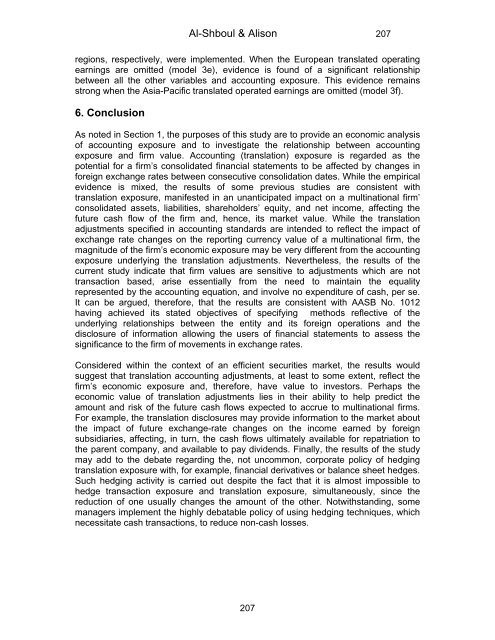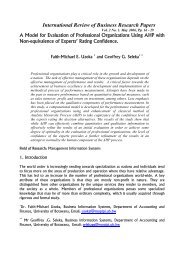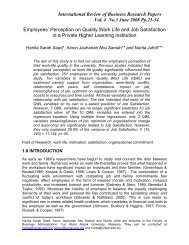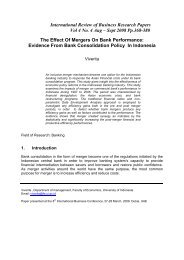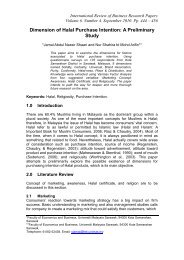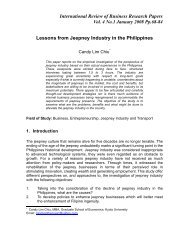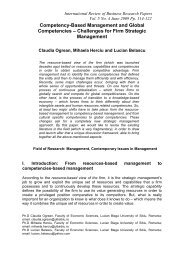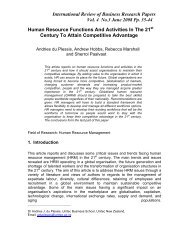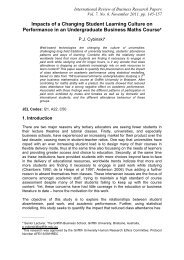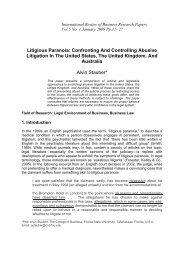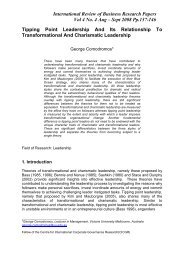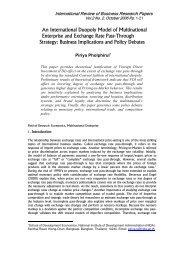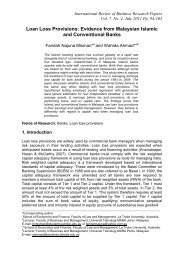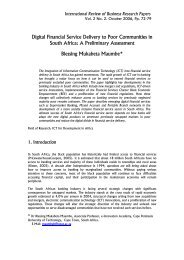Translation Exposure and Firm Value, Evidence From Australian ...
Translation Exposure and Firm Value, Evidence From Australian ...
Translation Exposure and Firm Value, Evidence From Australian ...
You also want an ePaper? Increase the reach of your titles
YUMPU automatically turns print PDFs into web optimized ePapers that Google loves.
Al-Shboul & Alison 207regions, respectively, were implemented. When the European translated operatingearnings are omitted (model 3e), evidence is found of a significant relationshipbetween all the other variables <strong>and</strong> accounting exposure. This evidence remainsstrong when the Asia-Pacific translated operated earnings are omitted (model 3f).6. ConclusionAs noted in Section 1, the purposes of this study are to provide an economic analysisof accounting exposure <strong>and</strong> to investigate the relationship between accountingexposure <strong>and</strong> firm value. Accounting (translation) exposure is regarded as thepotential for a firm’s consolidated financial statements to be affected by changes inforeign exchange rates between consecutive consolidation dates. While the empiricalevidence is mixed, the results of some previous studies are consistent withtranslation exposure, manifested in an unanticipated impact on a multinational firm’consolidated assets, liabilities, shareholders’ equity, <strong>and</strong> net income, affecting thefuture cash flow of the firm <strong>and</strong>, hence, its market value. While the translationadjustments specified in accounting st<strong>and</strong>ards are intended to reflect the impact ofexchange rate changes on the reporting currency value of a multinational firm, themagnitude of the firm’s economic exposure may be very different from the accountingexposure underlying the translation adjustments. Nevertheless, the results of thecurrent study indicate that firm values are sensitive to adjustments which are nottransaction based, arise essentially from the need to maintain the equalityrepresented by the accounting equation, <strong>and</strong> involve no expenditure of cash, per se.It can be argued, therefore, that the results are consistent with AASB No. 1012having achieved its stated objectives of specifying methods reflective of theunderlying relationships between the entity <strong>and</strong> its foreign operations <strong>and</strong> thedisclosure of information allowing the users of financial statements to assess thesignificance to the firm of movements in exchange rates.Considered within the context of an efficient securities market, the results wouldsuggest that translation accounting adjustments, at least to some extent, reflect thefirm’s economic exposure <strong>and</strong>, therefore, have value to investors. Perhaps theeconomic value of translation adjustments lies in their ability to help predict theamount <strong>and</strong> risk of the future cash flows expected to accrue to multinational firms.For example, the translation disclosures may provide information to the market aboutthe impact of future exchange-rate changes on the income earned by foreignsubsidiaries, affecting, in turn, the cash flows ultimately available for repatriation tothe parent company, <strong>and</strong> available to pay dividends. Finally, the results of the studymay add to the debate regarding the, not uncommon, corporate policy of hedgingtranslation exposure with, for example, financial derivatives or balance sheet hedges.Such hedging activity is carried out despite the fact that it is almost impossible tohedge transaction exposure <strong>and</strong> translation exposure, simultaneously, since thereduction of one usually changes the amount of the other. Notwithst<strong>and</strong>ing, somemanagers implement the highly debatable policy of using hedging techniques, whichnecessitate cash transactions, to reduce non-cash losses.207


